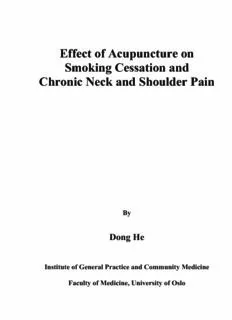
Effect of Acupuncture on Smoking Cessation and Chronic Neck and Shoulder Pain PDF
Preview Effect of Acupuncture on Smoking Cessation and Chronic Neck and Shoulder Pain
Effect of Acupuncture on Smoking Cessation and Chronic Neck and Shoulder Pain By Dong He Institute of General Practice and Community Medicine Faculty of Medicine, University of Oslo © Dong He, 2008 Series of dissertations submitted to the Faculty of Medicine, University of Oslo No. 617 ISBN 978-82-8072-460-1 All rights reserved. No part of this publication may be reproduced or transmitted, in any form or by any means, without permission. Cover: Inger Sandved Anfinsen. Printed in Norway: AiT e-dit AS, Oslo, 2008. Produced in co-operation with Unipub AS. The thesis is produced by Unipub AS merely in connection with the thesis defence. Kindly direct all inquiries regarding the thesis to the copyright holder or the unit which grants the doctorate. Unipub AS is owned by The University Foundation for Student Life (SiO) To my dear parents TABLE of CONTENTS TABLE of CONTENTS.......................................................................i PREFACE...........................................................................................iv ACKNOWLEDGEMENTS...............................................................vi LIST of PAPERS................................................................................ix SUMMARY..........................................................................................x DEFINITIONS and ABBREVIATIONS.......................................xiii DEFINITIONS..............................................................................................................xiii ABBREVIATIONS.........................................................................................................xvi 1 INTRODUCTION and BACKGROUND................................1 1.1 BriefcommentonTraditionalChineseMedicine..............................1 1.1.1 MainprinciplesofTCM.......................................................................................2 1.1.1.1 Yin-Yang;Zang-Fu..........................................................................................2 1.1.1.2 Qi,Jing-Luosystemandacupoints.................................................................2 1.1.2 Suggestedpathogenesisoftobaccosmoking,accordingtoTCM.......................4 1.1.3 Suggestedpathogenesisofchronicneckandshoulderpain,accordingtoTCM ............................................................................................................................5 1.2 Approachestoquitsmoking.................................................................6 1.2.1 Briefproblemstatementandoverviewofmethodsusedfortreatment..............6 1.2.2 Acupunctureforsmokingcessation.....................................................................8 1.2.3 Limitationsofpreviousstudiesonacupunctureusedforsmokingcessation..10 1.3 Chronicmusculoskeletalpain............................................................12 1.3.1 Problemstatementandbriefoverviewofmethodsusedfortreatment.............12 1.3.2 Acupunctureforchronicmusculoskeletalpain................................................13 1.3.2.1 Acupunctureforchronicneckandshoulderpain.........................................13 1.3.2.2 Acupunctureforchronicmusculoskeletalpain-relatedheadache................16 1.3.2.3 Acupunctureforchronicmusculoskeletalpain-relatedsocialand psychologicalvariables................................................................................................16 DongHe i 1.3.3 Limitationsofpreviousstudiesonacupunctureforchronicneckandshoulder pain......................................................................................................................18 2 OBJECTIVES and APPROACHES......................................20 3 METHODS ...............................................................................21 3.1 Studydesign.........................................................................................21 3.2 Thepopulationsample........................................................................22 3.2.1 StudyA:Acupunctureforsmokingreduction/cessation..................................22 3.2.2 StudyB:Acupunctureforchronicneckandshoulderpain.............................22 3.3 Acupuncturetreatments.....................................................................23 3.3.1 TheoriesandprinciplesofTCM........................................................................23 3.3.2 Acupuncturetreatmentsusedinthepresentstudy............................................24 3.4 Measurements......................................................................................27 3.4.1 Bloodsamplingandanalysis..............................................................................27 3.4.2 Questionnaire......................................................................................................27 3.4.3 Clinicalexaminations.........................................................................................28 3.5 Statistics................................................................................................28 4 RESULTS: SYNOPSIS of PAPERS.......................................30 4.1 PaperI..................................................................................................30 4.2 PaperII.................................................................................................31 4.3 PaperIII...............................................................................................32 4.4 PaperIV...............................................................................................33 5 DISCUSSION ...........................................................................35 5.1 Methodologicalconsiderations...........................................................35 5.1.1 Randomerror,powercalculation......................................................................35 5.1.2 Sampleselection.................................................................................................36 5.1.2.1 Subjects’characteristics................................................................................36 5.1.2.2 Drop-outsandmissingdatainthefollow-upstudies....................................36 5.1.3 Acupuncturetreatments,reliabilityandvalidity...............................................37 5.1.3.1 Standardizedacupuncturetreatment.............................................................37 DongHe ii 5.1.3.2 Intensiveacupuncturetreatment...................................................................37 5.1.3.3 DeQisensation.............................................................................................37 5.1.3.4 Acupuncturepractitioner..............................................................................38 5.1.4 Outcomemeasurements;reliabilityandvalidity...............................................38 5.1.4.1 Questionnaire................................................................................................38 5.1.4.2 Physio-biochemicalorclinicalexamination.................................................39 5.1.4.3 Furtherformalmethodologicalissues..........................................................40 5.2 DiscussionofmainfindingsinStudyA.............................................41 5.2.1 Short-andlong-termeffectsofacupunctureforsmokingreductionand cessation..............................................................................................................41 5.2.2 Theacupointsusedforsmokingcessation........................................................41 5.2.3 Tasteoftobaccoanddesiretosmoke.................................................................42 5.3 DiscussionofmainfindingsinStudyB.............................................43 5.3.1 Short-andlong-termeffectsofacupunctureonpainreduction......................43 5.3.1.1 Reductionofchronicneckandshoulderpain...............................................43 5.3.1.2 Reductionofchronicneckandshoulderpain-relatedheadache..................43 5.3.1.3 Long-termeffectofacupunctureonchronicpainreduction.........................43 5.3.2 Short-andlong-termeffectsofacupunctureforchronicmusculoskeletalpain- relatedsocialandpsychologicalvariables.........................................................44 5.4 Studydesign.........................................................................................45 5.4.1 Acupuncturedose...............................................................................................45 5.4.2 SimplifiedacupuncturetreatmentmethodinWesternacupunctureresearch48 5.4.3 Possibleplaceboeffectandvalueoflongtimefollow-up.................................48 5.5 Correlationsandmodelsforpossiblemechanismsofaction..........49 5.6 Generalization......................................................................................52 6 CONCLUSIONS.......................................................................53 7 REFERENCES.........................................................................54 ERRATA PAPERS APPENDICES DongHe iii PREFACE Traditional Chinese Medicine (TCM) came into my life in an early age. My mother, a physiologist,wassenttothecountryside,asweremanyoftheacademicsattheendof1960s. In the poor countryside, she became an after-work “bare-foot doctor”, and used acupuncture tohelpthefarmersinvillages.Iwassoproudofmymother,andatthesametimefascinated andinspiredbythemagiceffectsofthosesmallsilverneedles. After several years studying and working at university in Beijing, I came to Norway in the middleofthe1980s,andfinishedamaster’sdegree(Cand.Scient.)inphysiologyandworked with related research projects. Nurtured by science and wisdom from both East and West, I havenotjust enriched myknowledge, butalso givenpossibilitiestomeet challenges. Oneof themostinterestingchallengesishowtocombinethebestoftheEasternandWesternmedical traditionstoimprovehealthcareforpeople. At the time, a Norwegian would stare at me and wonder how someone with a headache is treated by acupuncture. One of my first patients in 1992 came to me just to look at the needles. We all should be grateful to the Norwegian Research Council for its pioneering program “Projects in alternative medicine”. This initiative opened the way for research on acupuncture in Norway, and gave me a real chance to study evidence based acupuncture which is necessary to introduce ancient acupuncture as a medical treatment in the present world. I have for a while been lost with too many“divisions” in mylife. Growingup in China and livinginNorway,twodifferent cultures, traditions andlanguages, all thesedividedmybody andmind.Inmyprofession,writingliteratureandscientificresearcharedividingmythinking andtime. Ihaveusedmorethan10yearstolearnthatanindividualmightindeedexistintwodifferent worldsatthesametime.Ihavetriedtoextractthebestofthetwoworlds,andre-constructmy DongHe iv PREFACE ownspirit. Ihavedescribedthisdiscoveryinthepostscriptofmypoemcollection“Butterfly Mist”of2002. Ittookmemorethan10yearstoobtainthePhDdegree,andthisprocesshashelpedmeoutof another puzzle. The impulsive and fantasy thinking of writing fiction, and the rigorous attitudeinscientificresearchareverydifferent,butcanco-existinthesamemind.Emotional expressionorprogressivereasoning,theyallaimtodiscoverthe“truth”ofourlife. In these long years of PhD-study, how many times I experienced doubt, hesitation, disappointment and loneliness. Those moments when my hands became wet from nervousness,thosesleeplessnightswanderingontheedgeofgivingup,andfinallythedesire ofdiscovering“truth”overcameall theotherthoughts and lures. Ikept on goinguntil today. The outcome of this book marks the end of my ten year “long march”. My tears of joy and happinessaregoingtocleanupthenextstart–inliteratureorscience. HeDong Oslo,28thJanuary2008 DongHe v ACKNOWLEDGEMENTS Iwouldliketoexpressmysincerethankstomysupervisor,ProfessorArneT.Høstmark,for his guidance and encouragement throughout the course of my candidature. Without his wisdom,kindnessandsupport,especiallyinthelastperiodofmywriting,Iwouldneverhave completedthisstudy. Alsotomyadditionalsupervisor,DrJonI.Medbø,andpaperco-authorsDrKajB.Veiersted and Dr John E. Berg, I record my sincere appreciation for their co-operation, effort, and interestingscientificdiscussionsduringtheproject. To Professor Gunnar Tellnes, I would like to thank his open mind and warmth, which has givenmethestrengthtogoforthinmydifficulttime.ToProfessorEspenBjertness,whoread the thesis and gave useful comments. To Professor Dag Bruusgaard, as the leader of the institute,hisencouragementatthedeepestperiodofmystudyisstronglyappreciated. Iacknowledgeanumberofindividualswhosupportedmeinspecificexperimentalaspectsof the project: Eva Kristensen, Eva Thorsby, and Ida Bye for collection and measurement of bloodsamples;andtothesedoctorswhorecruitedthesubjectsforproject.AlsoIexpressmy gratitude to Morten Ariansen and Jan Erik Michaelsen for their technical advice, to Ellen Christophersenand Frøydis Asklundfortheirhelponliterature collection, and to DrMarcus Kenrickforhisvaluableproofreadingofthisthesis. Thanks to all members of the section of Preventive Medicine and Epidemiology, who have provided apleasant placeto work, especiallytoAnn-KarinValleandDr FlorenceDrageseth for laughs and tears shared, and for the worthy thoughts and discussions had through the years. Thanks to Dr Elin Olaug Rosvold and Dr Anne-Lise Middelthon in the institute for theirencouragements. DongHe vi
Description: